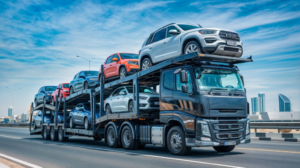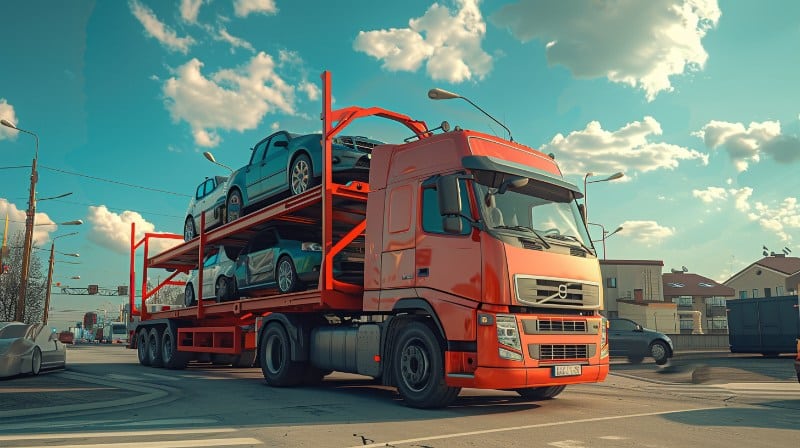It is not an easy task to ship a vehicle that does not run across the country, but consider this: if you are relocating, buying a second-hand vehicle from another region, or if the vehicle is broken and needs to be transported, you need to know the guidance for shipping non-functional vehicles. In this article, we will explain each step of the journey that aims to ensure a non-running vehicle gets shipped across borders without any hindrance as well as what one can do so the non-operational vehicle reaches the destination in the optimal state.
Special Care Required While Transporting Non-Operational Vehicles
Transporting a non-operational vehicle, when compared to functional ones, poses many troubles to the trying companies. The most challenging part of moving a non-operational vehicle is how the vehicle is going to be loaded or unloaded on the transport and off the ferry. Auto transporters usually make use of ramps in order to drive cars into the truck, but if the vehicle is not working, this case becomes complicated.
Specialized non-operational vehicle transport services help solve these concerns. To make matter worse, many transport companies possess modern equipment containing winches, flatbed trucks, and even cranes designed to help transport vehicles that cannot move by themselves.
Examples of Non-Operational Vehicles:
– Vehicles with engine or transmission problems
– Missing or flat tires
– Broken mechanical parts like axles
– Vehicles that have suffered collision damage

Procedures for Shipping Vehicles That Cannot Operate
Shipping of non operational vehicles requires special attention in order to achieve the necessary standards. Below is what is likely to happen:
1. Selecting the Best Transporter
The first thing you will do while dealing with a non operational vehicle is selecting a suitable grade transport service. Vehicle moving companies are not the same, and some of them are less equipped to deal with broken cars, so make sure they have the correct tools. Companies specializing in the transfer of non-operational vehicles should have flatbed trucks or car carriers that include winches.
Consider the following when choosing a transport company:
– Customers assessments and brand standing
– Transport tools like winches or flat-beds
– Experience within the industry with Non-running vehicles
– Insurance and Licensing.
2. Vehicle Preparation
The Transport Company performs all services but certain measures must be taken prior to rest depositing to avoid unwanted issues.
– Removing Personal Effects: Personal belongings are prohibited from being in the vehicle so it is critical to remove all kept items whether impactful or insignificant.
– Car Battery Disconnect: As added insurance for shipping a non-running car, disconnecting the battery is a recommendation, especially after a prolonged idle duration.
– Take Pictures: Ensure the vehicle is documented before for potential argumentation disputes that may trigger on a transit layover.
– Check Vehicle Fluid Levels: Examine ensure fluids such as brake fluid, oil and coolant are at satisfactory so as a avoid damage during the transport process.
3. Car That Does Not Run
It is more challenging to load a car that does not run as compared to one that does. If the car is non-operational, is unable to drive onto the transport truck, and is being picked up by a transport company, they will employ modern tools like cranes or winches for truck loading. This is one of the essential processes as the vehicle is supposed to be fastened in a particular way that it does not move and get damaged during transport.
4. Transport and Delivery
When your car has been loaded and strapped down, the next step is movement. Transporting the vehicle can either be done using closed transporters and open transporters depending on how far the car needs to be taken. Closed transporters can shield the car better from rain and stones on the road while open transporters are cheaper.
Flatbed is the most preferred type of transport for cars that do not run because it is much easier to load and unload the vehicles.
Anticipated Events Within the Transit Phase
Following the loading process, the vehicle will embark on its cross-country journey. A good transport company should provide some form of monitoring service at this stage. Some companies may have online systems that will allow them to view the GPS and know where the vehicle is at all times.
The duration of travel for a non-operational automobile is dependent on the distance and route of travel. In general, interstate car transportation takes approximately one to two weeks (7 – 10 days) taking into consideration the seasonal changes, traffic, and weather alongside the transport route.
Elements that can seamlessly interrupt the set delivery date:
– Environmental Factors: Extreme weather conditions such as floods and snowstorms slow shipping.
– Road Traffic: The amount of traffic or accidents on the route may also increase the delivery time.
– Traffic Along Route: The more a direct route taken, the faster delivery will be made. However, some places have limited availability to transport carriers, which may slow down the process.
Expenses Incurred in the Transportation of a Nonoperational Vehicle
The expenses incurred in the transportation of a nonoperational vehicle across the state vary with a number of factors like the distance of transport, size and weight of the vehicle, type of selected transport, and the vehicle’s condition. Additional charging is inflicted by the fact that nonoperational cars need extra care during unloading and loading of the vehicle.
Factors that Impact the Cost of Shipping:
– Distance: Longer distances increase cost.
– Vehicle’s Size and Weight: Heavier and bulkier vehicles cost excess amounts.
– Condition of the Vehicle: Vehicles that are not running may require additional specialized equipment for transport.
– Type of Transport: Open transport costs less than flatbed and enclosed transport.
On the higher side, the expenses for transporting a nonoperational vehicle cross-country is no less than $600, while on the lower side, it can go as high as $1,500. The best way to estimate the cost is by requesting transport companies for their quotes.
Why Carson Shipping Non-Running Car Transport Preferred.
Transporting non-running cars is easy and dependable at Carson Shipping. We’ve dealt with all types of vehicles for a number of years, so we appreciate the unique difficulties attached to shipping a non-running car. We have winches and flatbed trucks at our disposal, which allow us to load, transport, and deliver your vehicle safely.
Why Us?
– Experienced Staff: Our team oversees non-running vehicles with unparalleled attention to detail.
– Specialized Equipment: We transport non-running vehicles using winches and flatbed carriers with the utmost precision.
– Value For Money: Our estimates are straightforward and free of hidden charges while our prices remain low.
– Exceptional Customer Service: We focus on providing superior help and assistance to customers throughout the shipping process.
Conclusion: Non-Running Car Shipping Simplified.
There are more options and strategies than are normally presented when moving a non-operational vehicle throughout the United States. By selecting an authentic transport company and understanding the procedures, you can guarantee that the vehicle will arrive at the specified destination securely and on time. Whatever the reason your car is inoperable, whether due to mechanical problems or not starting- the specialized services provided by Carson Shipping will serve you right.
Contact Carson Shipping today in case you want a swift estimate for transporting your inoperable vehicle for long distance travel. Allow us to manage all logistics while you prioritize what is really important!

